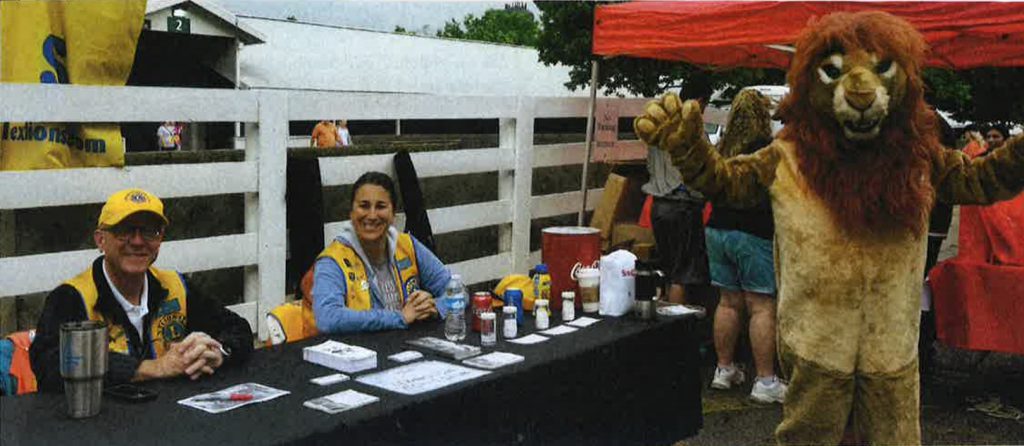Pat Ryan left the 2017 Lions Clubs International Conference in Chicago with a mission: He would return to his home state of Kentucky to help screen 100,000 people for diabetes.
Ryan was motivated to join the fight against the global diabetes epidemic in part because he knew people in his adopted home state were suffering.
“We have one of the highest rates of diabetes in the country,” he says. According to Kirsten Rowland, associate director at the American Diabetes Association in Lexington, approximately 567,000 people in the Bluegrass State have diabetes. “Of these, an estimated 108,000 have diabetes and don’t know it,” she says.
Ryan was also motivated by what he’d seen on the conference stage. Watching former International President Bob Corlew call on Lions to help prevent and raise awareness of diabetes was inspiring-and, in a way- serendipitous. For this retired science teacher and athletics coach, the diabetes epidemic wasn’t just a worthwhile cause to rally behind – it was a disease he’d known personally.
At 5’8″ and 160 lbs, Ryan is slender. But in 2015, his weight hovered around 260. He was severely obese. “I could barely walk down the street without huffing and puffing,” he says.
He was also diabetic.
Then Ryan had a doctor’s appointment that changed everything. His physician diagnosed him with Stage 3 Chronic Kidney Disease. “That was the panic button,” Ryan says. He’d had enough.
Ryan began eating more fruits and vegetables and walking two to four miles a day. Over time, he lost 100 pounds. A year later, Ryan visited his nephrologist and came away with a remarkable new diagnosis: not only was his Chronic Kidney Disease down to Stage 1, which is normal for a 71 year old; but after 16 years, his physician updated his diagnosis from “diabetes” to “pre-diabetes.” His blood glucose levels were well within the norm and he no longer needed to take medication.
It was during this time that Ryan attended the Centennial celebration in Chicago and was moved to heed the call for Lions to mobilize to help those who have diabetes or are at risk of developing it. When he returned to Kentucky, Ryan began working on a LCIF Diabetes Grant application that would provide his Lexington Lions Club with the funds needed to host diabetes screenings and then conduct follow-up meetings with at-risk individuals. If the grant is secured, the club aims to start small by screening 10,000 to 20,000 people first and then expanding from there.
Richard Heine, chairman of the Fayette County Diabetes Coalition (FCDC), is helping Ryan and the Lexington Lions Club with the application. Formed in 2002, the FCDC works in affiliation with the health department and several local schools, churches, businesses, and hospitals. “It was formed to look at diabetes as a community problem, rather than only a medical problem,” says Heine. Heine believes a community-wide approach is key to curb the diabetes epidemic.
“Pat has taken an important step and aligned himself with local community efforts in his desire to make a difference,” says Heine. “The same efforts will be needed throughout the country if Lions are to succeed.”
Heine thinks it’s important that any Lions Club members wishing to support the diabetes cause in their own communities first do as Ryan did and “identify champions”.
“Find out what is being done in the community and by whom, and then seek to discover ways to assist and participate,” he advises.
One of the first organizations Ryan contacted, for example, was the American Diabetes Association in Kentucky, who put him in touch with their associate director, Kirsten Rowland. Together, Ryan and Rowland helped plan and promote several local diabetes awareness and fundraising events.
From the onset, Ryan was insistent that the Lexington Lions Club do more than serve as event financiers.
“If we’re going to serve, serving is about more than giving checks,” Ryan says. When the Lions helped the ADA put on the Tour de Cure in May 2018, for instance, he and other Lions “helped set up signs, set trash cans, and helped set up booths.” Through his walk/run/cycling event the ADA raised US $200,000 for diabetes research, education, and advocacy.
Ryan also enlisted the ADA’s help in promoting Diabetes Kids Day at the Lexington Lions Club’s annual Bluegrass Faire. The fair featured music, food and 100 amusement rides and carnival games. The event provided an opportunity for children with diabetes to make new friends and enjoy the fair free of charge.
Rowland comments that the Diabetes Kids Day was “our largest event of the year.” More than 100 children and families attended. She considers events like these important because they help connect diabetic children with one another so that they can “share their struggles, triumphs and ultimately provide a vital support system.”
One of the Diabetes Kids Day attendees was Maya Young, an eight year old with Type 1 diabetes who has served as an ADA Youth Ambassador for the past two years. Her mother, Karin Young, says that Maya “loved riding all of the rides and meeting other kids just like herself.”
Young recommends Lions host events designed to educate parents about the signs and symptoms of Type 1 diabetes in children. “I feel lucky to have figured out my two-year-old had diabetes in just four days,” commented Young. “Some children end up in the hospital fighting for life because people are unaware.”
Rowland agreed that more education is needed. “I think a big challenge is getting important educational information out to those who need it,” she says. “To fight the diabetes epidemic, we need to do more screenings and then get information into the hands of those pre-diabetes and those diagnosed to help prevent and manage diabetes.”
Though Ryan faces an uphill climb in his mission to screen 100,000 Kentuckians, he remains optimistic – in part because he knows he won’t have to do this alone. Not only does he have the support of his club, the Fayette County Diabetes Coalition and the American Diabetes Coalition and the American Diabetes Association, but he also has the support of the global network of Lions. “This is encouraging,” he says.
“Because of Lions, I feel more empowered. They’ve got my back. I’ve got the Lions Club behind me.”
In the meantime, Lexington Lions have been working to raise both funds and awareness. In 2017, the Bluegrass Fair, which they’ve been hosting for nearly 60 years, raised US $175,000 for more than 20 local charities including the ADA. Ryan estimates that US $12,5000 of the profits from 2018’s fair will be donated to charities that support diabetes prevention and treatment.
The club has celebrated their progress by sharing service photos on Facebook-the club’s two Facebook pages have nearly 13,000 followers-and through local media outreach. Recently, their PR efforts have seen some success. “We had great coverage of Diabetes Kids Day on a local TV station and a front-page story in our local newspaper,” says Ryan.
Rowland is grateful for work Pat Ryan and the Lexington Lions Club have done to help the American Diabetes Association Kentucky and recommends Lions everywhere do their part to get involved. Four hundred million people have diabetes worldwide, with this number expected to rise to 650 million people. “It’s going to take all of us to help make a difference in diabetes and ultimately find a cure.”
Originally published in Jan 2019 – LionMagazine.org



I am currently working within my organization through the UK Diabetic Learning Collaborative. We have been working diligently to improve DSMES opportunities to our patients. We have also investigated the possibility of offering diabetic retinopathy screenings since this is a recommendation for prevention of blindness in patients with diabetes. Unfortunately, we have discovered the majority of insurance companies do not pay for this service as a screening and only cover if the patient already has retinopathy which is too late. We want to help in preventing and early detection using a RetinaVue scanner. However, the cost is around $10, 000 for the viewer. Since insurance will not pay for a screening, there is no way to pay for the scanner. UK does offer reading the screens for a fee of $10 for those that have a scanner. Does the LIONS Club have a program to assist with this or offer retinopathy screening events?
Thanks,
Debra